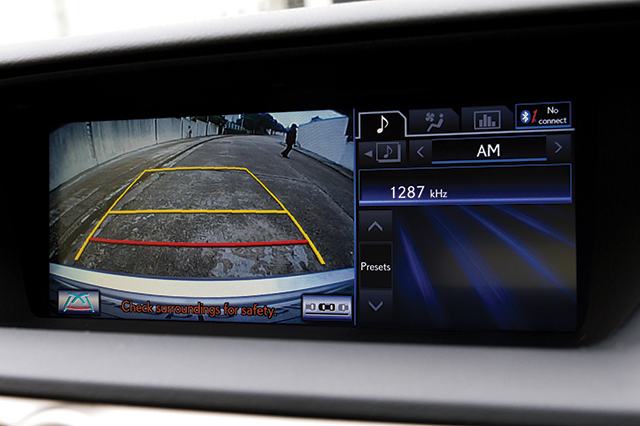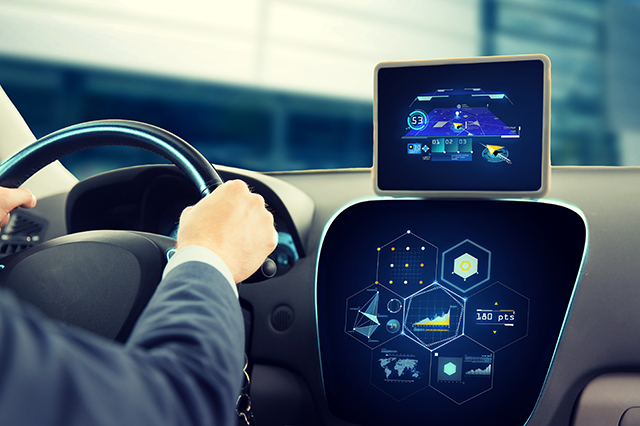There’s a lot to think about when buying a new car – horsepower, gas mileage, space and, of course, safety. With distracted and reckless driving behavior on the rise, it’s becoming more and more important to invest in the most reliable car possible. Every year, new car safety features like blind spot monitoring and lane keeping assist come around. And consumers can expect to find even more advanced driver safety functions in the future.
But with new advancements springing up left and right, it can be difficult to keep track of exactly what each does. Here’s a rundown of some of the most popular and useful car safety features on the market.
Anti-Lock Brakes
Anti-lock brakes prevent wheel lockup and skidding that can occur with conventional brakes. This keeps more of the tire surface in contact with the road, giving the driver greater ability to steer to safety. ABS brakes won’t stop a car quicker than conventional brakes, but they do provide more control.
Forward Collision Warning with Automatic Braking
Rear-end crashes are the most common type of crash in the U.S., which explains why this next safety feature was developed. Using front-facing sensors, this system is designed to scan the road ahead and alert drivers of an imminent crash. However, while the forward collision system can sense danger, it won’t help you avoid it. That’s why this safety feature is often paired with automatic braking.
While some crash prevention systems will only provide a warning and prepare the brakes for full stopping power, others apply the brakes automatically to prevent a crash. This safety feature combination just might be the reason your next zone-out moment isn’t fatal. If your budget only allows for one add-on, crash mitigation should be a major contender.
Advanced Cruise Control
While typical cruise control holds vehicle speed as set by the driver, Advanced Cruise Control (ACC) varies the speed based on traffic. For example, if the driver sets cruise control at 65 mph but traffic slows to 55 mph, ACC automatically reduces your speed until traffic clears. In some cases, these systems can control speed down to a complete stop. As part of the ACC system, following distance is also calculated to keep the vehicle a safe distance from the one in front.
Traction Control and Stability Control Systems
Many vehicles combine these features. Traction control systems use the braking system to stop a wheel that is spinning and force the opposite wheel to turn. This may provide the necessary traction to get a stuck car moving again. Stability control also uses the brakes to help “steer” the car when it is skidding. Stability control doesn’t necessarily improve handling, but it does reduce the chance of getting into a skid.
Integrated Steering Wheel
Perhaps one of the simplest changes in newer car models is the fully integrated steering wheel. In an effort to keep drivers hands-free, steering wheels have been redesigned with control shortcuts to some of the most widely used car systems. Most drivers can change the radio station, control the volume, switch on (and off) the cruise control, pick up and end phone calls, and more, all from the buttons on their steering wheel. While it’s a small change, it makes a big difference in the driving experience.
Voice-Controlled Systems
While operating in-car systems without taking your hands off the wheel has become much easier, there are still times when a driver has to reach over and fiddle with controls. But some car manufacturers have taken the hands-free mantra one step further. Ford’s SYNC technology has introduced voice-activated controls for the radio, climate and even navigation systems. And while this isn’t a standard (yet), all signs show that the automotive industry is headed in that direction. Consumers should expect to talk to their cars a lot more in the future and it could prove really useful.
Lane-Keeping Assist
The lane monitoring safety feature has been popping up on more car models each year. Using road markings for reference, these systems detect if a driver is drifting into a new lane without a turn signal. Then, depending on the car make and model, the driver will be alerted with a chime, flashing light or vibration. Some systems will even step in with corrective steering or braking. More complex systems use a hands-free lane keeping system that can even slow and stop with the flow of traffic. But this is a moot option if you live in areas with a lot of backroads. Most systems still have trouble reading country and suburban lines. Lane keeping assist is one of the new car safety features best left for drivers who often use highways.

Blind-Spot Monitoring
Paired with lane keeping assist, blind spot monitoring can make traveling traffic-heavy highways and major roads much safer. The systems use sensors to detect when there is a car in your blind spot and then alert you with a visual or audible warning. And some more advanced systems take it even further, showing what’s in your blind spot using camera footage. This feature is likely to become standard on all vehicles in the future.
Pedestrian Detection
This system uses a camera and radar to “see” pedestrians a driver may miss. More advanced systems have used infrared technology to detect the heat produced by humans and animals to prevent collisions.
Backup Camera
Rearview cameras are now standard on all American market vehicles. This feature allows drivers can see live footage on the dashboard of what’s behind their car, making it easier to navigate parking lots, pulling out of driveways and other situations where it’s easy to accidentally hit something (or someone).
Rear Cross-Traffic Alert/Warning
Supplementing the backup camera, this system uses radar to look to the left, right and behind the vehicle as it backs out of a parking space. This is especially handy when you find yourself sandwiched between two large SUVs in a parking lot!
Headlight Improvements
Even this basic component has become more sophisticated. Manufacturers are adding features that turn the lights slightly when taking a turn or staying level when driving up and down a hill. Some European cars have headlights that automatically shut off or block some of the light momentarily to prevent blinding oncoming drivers.
While there are plenty of other new car safety features on the market, the ones listed above are arguably some of the most useful. However, adding additional systems and perks to your car can get expensive and ultimately, your budget will determine which ones you buy (if any at all). So, when making decisions, try to consider your driving environment.
Which car safety feature will benefit your lifestyle most?
Have a question about your car? Ask AAA’s Car Doctor John Paul.
3 Thoughts on “A Guide to Car Safety Features”
Leave A Comment
Comments are subject to moderation and may or may not be published at the editor’s discretion. Only comments that are relevant to the article and add value to the Your AAA community will be considered. Comments may be edited for clarity and length.


















Driving in the south and up I-81 yesterday was an eye opener. I was complaining about the delays when I happened upon the multi vehicle truck/car/ RV crash between exits 80-90 WHAT A MESS ????????. The city& rural areas were greatly impacted with traffic in n town and on the rural side roads. There must have been over 100 vehicles involved and it went on for hours. Forget rubber necking, it went on for miles. Trucks allowed in the passing lanes on 3 lane highways are a huge danger and they don’t get over. In addition where are the governors on the speed limits. ??? Sad to see and thank God I wasn’t in the midst of it all.
Important improvements are with head lights:
1) Turning them in the direction of the car turn, not just slightly, but sufficiently to lit road where are you going, when taking a turn. This will make turns safer and save time.
2) I drove half of my life in Europe. Standards for low beam are different in Europe and the US. American low beam gives light about as concentrated as high beam, but directed lower. European low beam is also directed lower, but is much less concentrated. When driving and looking straight American standard gives to the driver better observation of the road than European one, but, based on my experience in Europe and the US, the difference is very minor. The problem with American standard is than if a car going in opposite direction in front of you is going over a hill, it gives light right into your eyes blinding you with low beam like with high beam. Making head light level stay directed with the road when driving up and down a hill will give advantages or both, American and European standards, eliminating their disadvantages.
Hi Eugene! Thank you for your added information with European headlight standards. -MM